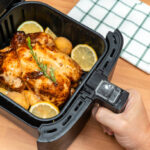There are so many different juicer styles and brands available on the market; thus, choosing the right one is a difficult task with many challenges. Unfortunately, there is no perfect juicer for everyone and everything, and you have to decide what requirements you have and select the one which most suits your needs.
Different style of juicers excels at different tasks while underperforming at others; some of them are laborious to use and clean, while they output the best juice quality and yield and vice versa.
Nevertheless, this buyer’s guide will break down the styles existing on the market and describe how they work, what parts they are constructed from, the ingredients they can juice and other function they can perform, the juice quality and yield they deliver, and finally their pros and cons. As a result, you will be able to select the best juicer based on your individual needs.
Although there are different classifications for juicers, we will divide them into Masticating, Centrifugal, and Press juicers.
Table of Contents
Centrifugal Juicers
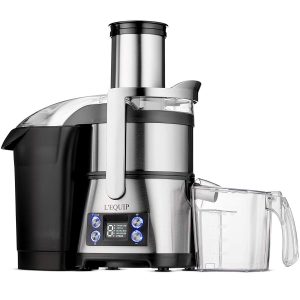
Centrifugal Juicer Construction Parts
A typical centrifugal juicer is constructed from the following parts:
- Main Body – the shell that houses the motor and base to which all parts are connected to;
- Juicing Bowl/Filter Bowl– the container with juice and pulp outlets inbuilt, where all the mechanical parts are operated, it collects juice and pulp and directs them out in the juice and pulp collectors;
- Filter Basket/Juicing Basket/Blade– it is constructed in the form of a basket with a disc on the bottom, which has inbuilt blades and sharp teeth and a wire cloth screen on the perimeter.
- Juicer Cover– is fixed to the top of the filter bowl and has a feeding chute inbuilt into it;
- Juice container– the container that collects the juice;
- Pulp container– the container that collects the pulp;
- Food pusher- pushes produce down into the feeding chute.
How the Centrifugal Juicer Works
The centrifugal juicer is fed via the vertically orientated feeding chute; the juicer is almost self-fed because it generally has a wide, approximately 3 inches chute opening. The ingredients enter the chute and fall directly inside the fast-spinning basket, which grates the produce with the blade and sharp teeth inbuilt into the base of the basket. The torn-apart ingredients are then pressed with centrifugal force against the filter screen and squeeze the juice that falls into the juicing bowl where it is directed out via the juicing outlet while the pulp is ejected through the pulp outlet.
The centrifugal juicers are very easy to use and very quick to process large volumes of ingredients. Having usually a wide chute, they require no or little produce preparation or pre-cutting for juicing, and also do not require any food pushing through the feeding chute.
The centrifugal juicers are very easy to assemble and use while a bit laborious to clean. They have a large perforated surface of juicing basket that is usually clogged with pulp and needs effort and time to clean properly.
Centrifugal juicers are the most affordable type of juicer ($70–300). Most of them are manufactured in china, some under well-known brands such as Breville, Hamilton Beach, Black + Decker, Cuisinart, L‑Equip, and Omega, while others are by generic producers and distributed under unknown short-live brands. In addition, reputable South Korean Brands also manufacture some Centrifugal Juicers.
Juice Quality
The nutritional value of juice extracted by the centrifugal juicer is not as high as the juice produced by masticating machines. Moreover, because the juicer operated at high speed, which causes juice oxidation and separation into the watery part and dense part; thus, it has a short shelf–life e and must be consumed immediately after processing.
Functionality and Juice Yield
Centrifugal juicers handle very well and output high yield following ingredients:
However, they struggle with leafy greens and soft fruits and are useless for juicing wheatgrass. In addition, the centrifugal juicer is not designed for performing food processing.
Pros and Cons of Centrifugal Juicers
Pros
- Very fast;
- Easy to feed and requires minimum ingredients pre-cutting;
- Very intuitive to assemble and use;
- Deliver high yields from hard produce such as carrots, beets, and oranges;
- Juice very quickly;
- A most affordable juicer with a price range of $70-$300.
Cons
- Laborious to clean;
- Deliver poor yield from leafy greens;
- Does not handle wheatgrass;
- Extract fewer nutrients from produce than masticating juicer;
- Outputs highly oxidized juice with a short shelf-life;
- Not versatile and does not perform food processing tasks;
- Separates juice into watery and dense parts;
Masticating Cold Press Slow Juicers
Masticating style juicers use a slowly rotating screw (auger/gears) to press the juice. The screw rotates at a slow 43–130 RPM speed and extracts the juice applying high pressure on the ingredients to squeeze the juice out. Hence, the Masticating juicers are often referred to as Slow or Cold Press juicers.
The masticating juicers extract high yield and high nutritional value juice using the cold press slow speed technology.
The masticating juicers are divided into three (3) major categories:
- Horizontal Juicers
- Vertical Juicers
- Twin Gear Juicers
Horizontal Single Auger Masticating Juicer
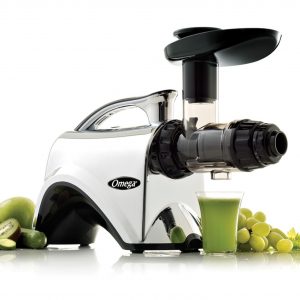
Horizontal Single Auger Juicer Construction Parts
- Main Body – it houses the motor and serves as a base for connecting all parts to it;
- Chamber – it is a part that comprises a feeding chute and encloses all parts for processing the ingredients;
- Auger — it is the screw that pulls and crushes ingredients inside of juicer chamber and presses them against the screen;
- Screen Cone — it is a cone with an inbuilt perforated screen that sits closely around the augur and auger; press the crushed ingredients against it to squeeze the juice;
- End Cap – the cap is attached to the end of the drum and seals all the juicer parts inside it; it also serves as the place where the pulp is ejected. For the horizontal design juicers, this part serves the role of pulp ejection and has caused the drum cap to see various modifications over time, resulting in the addition of pressure-adjusting nozzles in some juicers.
- Nozzles – comes in two types the pressure nozzle that regulates the level of pressure for the pulp ejection or the food processing nozzle that has different shapes for different task performance, for example, the pasta shaping and serves as a point of past extrusion;
- Juice Container – collects juice;
- Pulp Container – collects pulp;
- Food Pusher – it pushes the ingredients down to the feeding chute.
How the Single Auger Masticating Juicer Works
The ingredients are pushed with the food tamper into the juicer via the narrow (1.52 ‑2 inches) feeding chute from where it crashed and pulled through the juicer drum by slowly rotating the auger at 80–160 RPMs speed. The juice is pressed when the auger presses the crushed food against the perforated screen which surrounds the auger. The juice then drops down into the juice container while the pulp is ejected at the drum’s open-end through an affixed cap and/or nozzle.
The single auger machines are considered the easiest among all masticating juicers to assemble /disassemble and clean because they comprise a small number of parts that are intuitive to connect.
However, the single auger machine has a narrow feeding chute (circle 1.5 inches in diameter or crescent 1.5 X 2 inches), thus requiring pre-cutting of most ingredients for feeding and effort to push the food into the chute. The celery, carrots, and wheatgrass are the easiest to feed when juicing them with a single auger machine and do not require any pre-cutting.
Functionality
The single auger masticating juicer machine is a very versatile juicer and handles almost all ingredients well. In addition, they are the best at juicing:
- Wheatgrass and leafy greens;
- Celery juice;
- Apples and pears;
- Oranges and the majority of soft fruits and veggies;
However, a bit inferior at producing high yield while still very respectable yield from:
Besides, the single auger machine often comes with an additional attachment that allows them to perform a range of food processing tasks such as nut butter, frozen desserts, grinding coffee and beans, making baby food, and other homogenizing tasks. Some of the single auger juicers come with the nut oil extraction attachment.
Juice Yield and Quality
The single auger machine squeezes high-quality juice with a long shelf-life of up to 48 hours.
Pros and Cons of Horizontal Masticating Juicers
Pros:
- Easiest to assemble/disassemble and clean;
- A multifunctional juicer with high yield juicing leafy greens, wheatgrass, and celery and good at the firm and soft fruits and veggies, average at firm root veggies;
- Many come with an attachment for food processing tasks;
- Produce high nutritional value juice;
- Good choice of well-made South Korean Brands juicers;
- South Korean, USA, and European brands come with long warranties (usually 10+ years)
- The most affordable masticating juicer ($200–400);
- Quiet;
Cons:
- Require pre-cutting for most of the ingredients;
- Need some efforts to push ingredients through the feeding chute;
- Slow to process.
- It makes a maximum of 36–70 ounces of juice per cycle before it may need cleaning.
Vertical Masticating Juicers
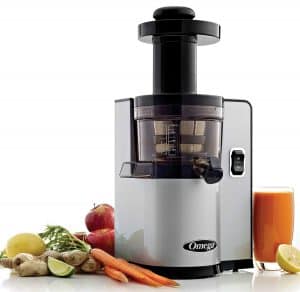
Vertical Masticating Cold Press Juicer Construction Parts
- Main Body – it houses the motor and acts as a base for fixing all parts to it;
- Juice Bowl/Chamber – it has inbuilt the juicing and pulp outlets and acts as an outer casing for parts that process the ingredients and squeeze the juicer (juicing screen, spinning brush, and auger);
- Auger — it is the fat-in-diameter screw that crushes ingredients and presses them against the strainer to extract the juice;
- Screen/Strainer - a wide vertical cone with meshed screens on the perimeter that surrounds the auger and acts as a part against which the auger presses crushed ingredients;
- Spinning Brush/Wiper- it spins around the outer side of the strainer and catches the juice from it since there is not enough gravity for small drops of juice to drop down the screen;
- Hopper /Feed Chute – it connects to the top of the juice chamber and functions as a cover for the chamber and feeding chute for fitting ingredients into it;
- Juice container – collects juice;
- Pulp Container – collects pulp;
- Food pusher – helps to push foods down to the auger through the feeding chute.
How The Vertical Masticating Juicer Works
Vertical Single auger masticating juicers function very similarly to horizontal ones. Still, it has an auger oriented vertically to the same axis as the feeding chute. So when food enters the feeding chute is pulled directly by the slowly rotating auger to the juice bowl that contains all the major processing parts. The auger rotates at a slow (43–60 RPMs) speed crushing the produce and pressing it against a large strainer to squeeze the juice. The strainer is surrounded by a spinning brush, the tool that wipes the juice from the strainer and directs it to the bottom of the bowl, where it gets out via the juice outlet. At the same time, the pulp is pulled by the auger down to the bottom of the bowl and directed out through the pulp outlet.
Although the Vertical single auger Juicers have a slow 43–60 RPMs rotational speed, they are considered to be the fastest slow juicers since they have an auger larger in diameter and larger in surface area. Thus they process more ingredients with every revolution than horizontal or twin gears juicers.
The vertical slow juicers are also considered the easiest to use because they generally have larger feeding chutes than horizontal ones. The standard feeding chute usually has a crescent shape with a size of 2 X 2.5 inches. The wide chute vertical juicer has 3 inches of feeding chute, so wide that they can be fed with whole apples or pears and does not require pre-cutting them. However, the vertical juicer has generally weaker torque and will require pre-cutting for firmer ingredients like carrots or beets; these ingredients will easily fit into the chute.
Although the vertical juicers have a larger screen and additional spinning brush parts, they usually come with a closable juicing outlet cap that allows for juicer pre-cleaning before disassembling it, so it helps remove some pulp and make easier final cleaning procedure.
Functionality
The vertical machines are the most versatile juicer style, which handles all ingredients and delivers respectable juice yield for most of them. This is the only juicer style which able to extract a high juice yield from soft fruits and vegetables. So it can extract:
- Celery juice;
- Citrus juice;
- Fruit juice;
- Leafy greens juice;
- Nut milk;
- Vegetable juice;
- Wheatgrass juice.
The Vertical Slow Juicers extract the highest yield across all juicer types from soft fruits and a decent yield from root vegetables, leafy greens, tropical berries, and others. However, the firm roots and celery must be cut into smaller pieces since the juicer can jam these ingredients.
Juice Quality
The juicer delivers high nutritional value juice the same as horizontal juicers, with a 48-hour shelf-life.
Vertical Masticating Juicers Pros and Cons
Pros:
- Vertical single auger juicers are the fastest slow masticating machines;
- Deliver high slow juicer quality juice;
- Most versatile mastication juicer style and handles all types of ingredients;
- Require little force to feed the ingredients and are considered almost self-feeding machines;
- Requires less food pre-cutting than other masticating juicers;
- Easier to use than other masticating juicer styles
- Easier to clean than Centrifugal juicers;
- Usually have a moderate footprint and do not occupy much of the counter space;
- Quiet;
Cons:
- Usually expensive machines ($450 — $650);
- Need pre-cutting for stringy and root produce.
Twin Gear or Triturating Juicers Masticating Juicer
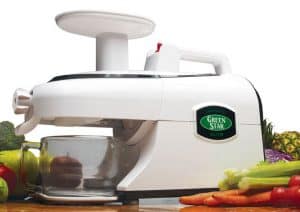
Twin Gear Juicer Construction Parts
Although all of the twin-gear machines use the same food processing technology, they differ greatly in many construction details. Here are the core parts of the typical Twin Gear Juicer:
- Main Body – houses the motor and the base for connecting all the juicer parts;
- Twin gears — two screw-shaped gears that rotate inward in alignment with each other and pull ingredients between them, then crushing and grinding before they are pressed for juice;
- Juicer Strainer/Screen – each twin-gear juicer model has its unique Screen style, but in general, it is a perforated wire cloth that lies tight around the gears, so the gears press the ingredients against it for juice squeezing;
- Juicing Drum – is unique for each twin gear machine; some of them resemble the single auger drum, and some are constructed of a few parts (safety hood for gears housing + Juice and pulp outlet). In general, it is an outer housing that contains the gears and screen and keeps produce processing tidy;
- Drum cap – present in some twin gear juicers only, it is fastened at the end of the drum guide and shuts all the juicer parts in place, It also acts as the channel for pulp ejection in the horizontal design; some juicer also has a pressure adjusting nozzles to regulate the pressure put on the pulp before ejection, so it tightened for firmer and loosened for softer ingredients;
- Juice container – collects juice;
- Pulp container – collects pulp;
- Food pusher – helps to push food through the feeding chute.
How the Twin Gear Juicer Works
The twin-gear machines extract the juice in a very similar process to the singles auger juicers do. First, the user feeds the produce through the vertically located narrow chute (1.5 ‑2 inches on average), pushing it with the food tamper. However, twin-gear machines employ two horizontally slowly rotating gears with 70–130 rpm speed instead of an auger. The gears drag ingredients, which are pushed down to it. Then triturate them, pulling through the Chamber and pressing against the juicing screen, squeezing the juice from it, while the pulp is ejected at the end of the nozzle at the end of the horizontally oriented Chamber.
The twin gear juicers are usually constructed with many parts, so they are laborious to assemble/disassemble and clean. They also require pre-cutting for most of the products due to the narrow chute, efforts while feeding them, and a large screen that takes time to clean.
The twin gear juicers are the most expensive machines juicer style ($450 -$1700); the good news is that they are not duped by the Chinese and are available from original manufacturers only.
Juice Quality and Yield
Twin gear juicers deliver the highest juice yield and quality across all available juicer styles on the market (and compete with hydraulic press machines only). They extract most of the nutrients and enzymes from the produce and deliver rich-colored juice with the longest shelf life of 48–72 hours.
Functionality
The twin gear delivers absolutely the best yield at juicing:
- Leafy greens;
- Celery;
- Wheatgrass;
- Root vegetables like carrots and beets;
- Firm fruits like apples and citrus fruits.
However, it will not shine at juicing softer fruits and veggies like pineapples or tomatoes and will show approximately 10% less yield than vertical and horizontal single-auger juicers for these ingredients. Thus, this juicer is not recommended if you plan to extract a significant soft fruit and vegetable volume.
Twin gear using the optional attachment can make nut butter, frozen treat, and other food processing tasks.
Twin Gear Juicers Pros and Cons
Pros
- Multifunctional and handle all types of ingredients;
- Deliver the best yield from juicing leafy greens, wheatgrass, firm veggies, and celery;
- Deliver best quality juice with the longest shelf life (48–72 hours);
- Most of them are made in Korea from high-quality materials;
- Come with long warranties;
Cons
- Generally more complicated to assemble than other styles of juicers;
- Require food pre-cutting for some ingredients due to the narrow feeding chute;
- Need some force to push food into the feeding chute;
- Laborious to clean;
- Take a long time to process juice;
- Most expensive style of juicers ($450-$1500).
Hydraulic Press Juicer
A Hydraulic Press is the first identifiable juicing machine that was invented in 1930 by Dr. Norman Walker. At present, it is known as the most efficient way to extract juice that delivers the same juice yield or 10% as the most efficient Twin Auger Super Angel Juicer. Therefore, the Gerson Institute recommends the Hydraulic Press for extracting the most nutritionally valuable juice from any type of produce.
Only three hydraulic press juicers are present today — the electric Norwalk Model 280, Pure Juicer, and manual Samson Welles Press Juicer (People’s Press).
Electric exert pressure 1750 ‑2600 psi bar.
Construction Parts
- Exterior — is a body that houses the motor and hydraulic press and where all other parts a connected;
- Offset Feed Tube – a chamber with the feeding chute and pulp outlet, which collects and grinds all the ingredients, then directs the wet pulp into the pulp collection bowl.
- Feed pan – is a hopper;
- Grids — grids regulate the fineness of the grind; the typical hydraulic press comes with a set of grids for different ingredients types;
- Grid Tray –it is used for holding the grids, hanging press bags, as a cutter removal tool or release tab; the grid tray is inserted into the offset feed tube;
- Cutter – it is a stainless steel helical blade that, together with a grid tray, grinds ingredients;
- Pressing Chamber – the part of the exterior where all the pressing parts are connected to;
- Press Plate with retainers – the plate that presses the bags with wet pulp from the bottom;
- Juice Tray – it is a tray where the bags with wet pulp are placed for pressing;
- Food Pusher — is designed to push all the products through the Feed Tube;
- Press Bags, Cloth, Cloth liners – the cloth where the wet pulp is placed before it goes under the press.
How the Hydraulic Press Works
The electric hydraulic presses such as Pure Juicer and Norwalk 280 Press extract the juice in 2 steps.
( 1 ) The ingredients pass through a triturating or grinding process on the grinder side of the machine. The grinder mechanism includes a feed tube with the cutter, grids, and grid tray sitting inside of a vertical stainless steel tube. The ingredients fit through the wide feeding chute of the feed tube and fall into the tube part where the blades rotate with the speed of 3450 RPMs; together with the grid and grid tray, they smash ingredients into the wet pulp, then the pulp is ejected via pulp outlet in the pulp collection container or into the cloth bag attached to the feed tube.
( 2 ) This wet pulp is then pressed in an electric hydraulic press on the pressing chamber part of the machine. The wet pulp inside of the cloth bag must be manually placed on the juice tray, which sits on the metal plate at the bottom of the pressing Chamber. The user starts the press operation by switching on the switcher on the side of the machine, and the metal press is moved upwards and presses the bags with pulp against the stainless steel stationary plate with a huge force of over 5000 pounds. This makes the juice flow out to the juice tray and then down via the spout into the juice container.
The Welles Press is a manual press, so it does not feature the triturating process and works only as a manually operated press. To extract juice with the manual Welles Press, the user has to cut produce manually or process it with the masticating juicer, then place wet pulp into the cloth bag and home it into the juice tray of the Welles press. Finally, the press is activated manually with the manual lever.
The Hydraulic press juicing process is very messy because it requires manually transferring the pulp into the pressing Chamber with juice spills and wet pulp drops around. The cloth bags also require washing and storing, and all this makes it quite laborious.
The Hydraulic Presses are made from stainless steel and thus very heavy to move around. They are also the most expensive juicer style, with the manual Welles press costing around $400 and electric hydraulic presses over $2000
Juice Yield and Quality
The hydraulic press is a very efficient juicing method that extracts juice via the cold press slow process and delivers the highest possible juice quality.
Even though it is widely marketed as the best juice quality and advocated by Gerson Institute, no independent scientific studies are confirming this fact. Many nutritionists and health professionals insist that twin gear juicers deliver the equivalent quality juice.
Functionality
Hydraulic Presses are truly multifunctional juicers and handle all types of ingredients and a range of food processing tasks:
- Hard veggies root like carrots and beets;
- Hard fruits like apples and pears;
- Ginger, turmeric;
- Celery;
- Citrus fruits;
- Pomegranates;
- Soft fruits like pineapple, banana, melon, peaches, and others;
- Soft veggies like tomatoes or cucumbers;
- Leafy greens such as broccoli, brussels sprouts, cabbage, and others;
- Berries, including cherry and grapes;
- Nut butter;
- Frozen dessert and shaved ice;
- Baby food;
- Jams;
- Pesto and sauces;
- Grind coffee;
- Shave and grate cheese.
Hydraulic Press Juicers Pros and Cons
Pros:
- Extracts an extra 10–20% more juice than any other juicer available;
- Delivers the highest possible juice quality;
- The Gerson Institute recommends the hydraulic press juicer is the best way to extract most nutrients from any ingredients.
Cons:
- Expensive ($400 — $2500);
- Time-consuming process;
- Require the use of cloth bags when juicing; that makes a lot of mess;
- The Norwalk juicer is extremely heavy.
Summary
How to decide between Centrifugal, one of the Masticating styles, and a Hydraulic Press Juicer?
Centrifugal juicers are perfect for busy people who wish to incorporate fresh juice into their diet and do not mind compromising on the juice quality and lower content of nutrients in the juice.
The centrifugal machine’s main advantage is the speed it processes to produce and the minimum food pre-cutting; you can make a cup of carrot juice in 30 seconds. The second advantage is that it is the most affordable juicer on the market and so common that you can find it in many department stores. However, the centrifugal juicer also has negative sides, the main one is that tends to aerate the juice and, as a result, destroys some nutrients in it. Another disadvantage is that this juicer handles only a limited range of products such as hard veggies and fruits such as carrots, apples, and other citrus fruits. It is almost useless for leafy greens and wheatgrass. It also hardly will suit noise-sensitive people as it is the nosiest style of juicer and will release similar to the blenders’ noise level.
Horizontal Single Auger Masticating machines are the most popular juicers among consumers because they are versatile and handle almost any type of ingredient well. They are easiest to use and clean and deliver a high quality and nutrient content juice. They underperform when juicer hard roots (delver still respectable yield), while excel juicing leafy greens, wheatgrass, and soft fruits; they also come with few attachments and are very good at performing food processing tasks such as nut butter and frozen treat making. The fact that single auger horizontal juicers are the cheapest masticating machine style also contributes to their popularity. However, these machines also have a negative side, such as they come with a narrow feeding chute and need pre-cutting for most of the ingredients, and that slow to process ingredients.
Vertical Cold Press Juicers are true multifunctional machines and are able to juice high-quality juice and deliver good yield from almost any ingredient, from firm fruits and veggies to leafy greens and soft fruits, and even berries deliver good yield all ingredients and high-quality juice. They are also very popular because they are the fastest masticating juicers across all slow cold press machines. However, they require pre-cutting for most ingredients. They are not as mighty with food processing tasks as horizontal single auger machines; however, some of the models come with food processing attachments. The only negative side they have is the price; the majority of them are available in the range of $450–600.
The twin gear machines are the juicers and are the true health enthusiast juicers. Although they have the highest juice quality and deliver the highest yield for the majority of the ingredients, they are very expensive and laborious to use and clean; they are also the slowest masticating juicers and require pre-cutting for most of the product types.
Hydraulic Press Juicers are recommended by Gerson instate of people who fight serious diseases because they deliver the highest possible level of nutrients in the juice. However, they are very difficult to use, messy, and slow to process ingredients while output is even slightly higher than twin gear machines’ juice yield. Besides, they are heavy, generally not user-friendly, and very expensive machines.
The Champion Juicer is a very well-made and durable machine; it is fairly quiet, excels at the roots, makes best-frozen desserts, and is good at food processing tasks, including nut butter. The champion juicer is quicker at ingredient processing than standard masticating juicers. However, it is slightly underperforms processing apples and firm fruits and not a good performer at leafy greens unless you buy the latest model 5000, which comes with a special auger for leafy greens. The juicer runs at 1725 RPMs speed and does oxidize the juice while the juice is tasty and rich. Nevertheless, the newest Champion 5000 model comes with 11 speeds where the lowest runs at 350 RPMs, so with this machine, you can enjoy the fast and slow masticating juicer benefits.
To our readers: We would like to let you know that you can find the rewritten copy of this original review here, the same as many other reviews. For confirmation, you can compare the date of the review publication.


